The BrowserSafeguard is an unwanted software from the adware (ad support software) family. Most often, the undesired program installs on the machine in a bundle with free applications that you downloaded and installed from the World Wide Web. Once it gets inside your PC system, it can alter certain machine’s settings such as start page, search engine and new tab page in order to redirect your’s browser to ad pages or configure your web browser to display a large amount of intrusive popup ads from various third-party ad networks.
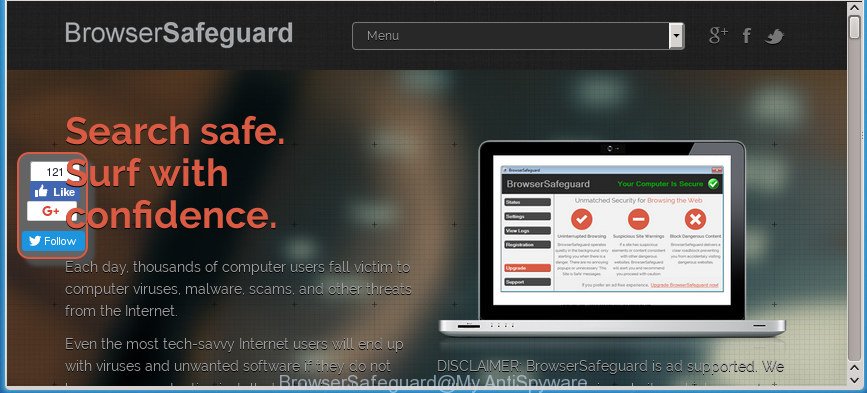
The BrowserSafeguard ‘ad supported’ software that cause annoying popup advertisements to appear, can attack your personal computer’s internet browsers like the Firefox, MS Edge, IE and Google Chrome. Maybe you approve the idea that the advertisements from it is just a small problem. But these unwanted BrowserSafeguard advertisements eat system resources. Even worse, it be able to gather your browsing history and confidential data, including passwords and credit card numbers. In the future, user info can be sold to third parties.
So, obviously, you need to remove the BrowserSafeguard adware as quickly as possible. Use the free guide below. This guide will help you clean your computer of the adware and thus get rid of the any annoying pop-up ads.
Remove BrowserSafeguard
There are a simple manual guide below that will help you to get rid of BrowserSafeguard ad supported software from your Windows PC. The most effective method to remove this ad-supported software is to follow the manual removal guidance and then run Zemana Anti-Malware (ZAM), MalwareBytes or AdwCleaner automatic tools (all are free). The manual method will assist to weaken this adware and these malicious software removal tools will completely remove BrowserSafeguard adware and revert back the Microsoft Internet Explorer, Firefox, Chrome and Edge settings to default.
To remove BrowserSafeguard, complete the following steps:
- Remove BrowserSafeguard adware without any utilities
- Remove BrowserSafeguard related software through the Control Panel of your PC system
- Delete unwanted Scheduled Tasks
- Remove BrowserSafeguard ‘ad supported’ software from Chrome
- Get rid of BrowserSafeguard from Internet Explorer
- Delete BrowserSafeguard from Mozilla Firefox by resetting internet browser settings
- Use free malware removal utilities to completely remove BrowserSafeguard adware
- Stop unwanted pop-up ads and other intrusive web-pages
- Where the BrowserSafeguard adware comes from
- To sum up
Remove BrowserSafeguard adware without any utilities
If you perform exactly the step by step instructions below you should be able to get rid of the BrowserSafeguard ad supported software from the Google Chrome, MS Edge, Firefox and Internet Explorer internet browsers.
Remove BrowserSafeguard related software through the Control Panel of your PC system
Some potentially unwanted apps, browser hijacking programs and ‘ad supported’ software may be removed by uninstalling the freeware they came with. If this way does not succeed, then looking them up in the list of installed applications in Windows Control Panel. Use the “Uninstall” command in order to get rid of them.
Windows 8, 8.1, 10
First, click Windows button

After the ‘Control Panel’ opens, click the ‘Uninstall a program’ link under Programs category as shown on the screen below.

You will see the ‘Uninstall a program’ panel as shown in the following example.

Very carefully look around the entire list of software installed on your machine. Most probably, one of them is the BrowserSafeguard ‘ad supported’ software which developed to redirect your web-browser to various ad pages. If you have many programs installed, you can help simplify the search of malicious applications by sort the list by date of installation. Once you have found a suspicious, unwanted or unused program, right click to it, after that press ‘Uninstall’.
Windows XP, Vista, 7
First, press ‘Start’ button and select ‘Control Panel’ at right panel like below.

After the Windows ‘Control Panel’ opens, you need to click ‘Uninstall a program’ under ‘Programs’ as shown below.

You will see a list of apps installed on your PC. We recommend to sort the list by date of installation to quickly find the apps that were installed last. Most likely, it’s the BrowserSafeguard adware that causes tons of undesired ads. If you’re in doubt, you can always check the program by doing a search for her name in Google, Yahoo or Bing. Once the program which you need to delete is found, simply click on its name, and then press ‘Uninstall’ as displayed in the figure below.

Delete unwanted Scheduled Tasks
Once installed, the ad-supported software can add a task in to the Windows Task Scheduler Library. Due to this, every time when you run your computer, it will display BrowserSafeguard ads. So, you need to check the Task Scheduler Library and get rid of all malicious tasks that have been created by malicious application.
Press Windows and R keys on your keyboard together. It will open a dialog box that titled as Run. In the text field, type “taskschd.msc” (without the quotes) and click OK. Task Scheduler window opens. In the left-hand side, click “Task Scheduler Library”, as displayed below.
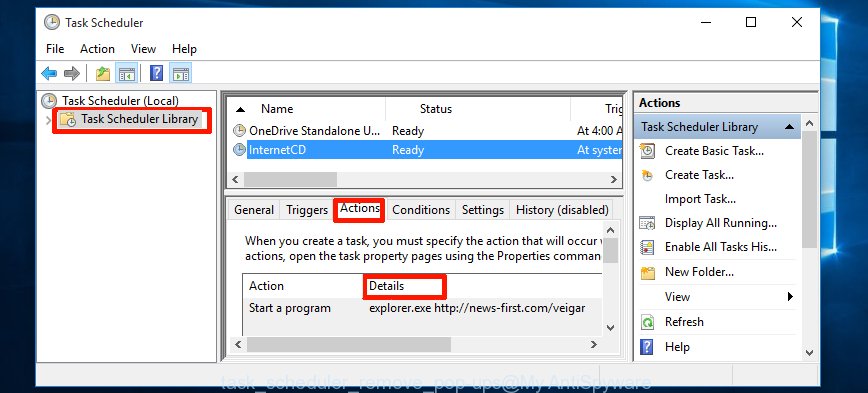
Task scheduler, list of tasks
In the middle part you will see a list of installed tasks. Select the first task, its properties will be show just below automatically. Next, click the Actions tab. Necessary to look at the text which is written under Details. If you are not sure that executes the task, then google it. If it’s a component of the unwanted applications, then this task also should be removed.
Further click on it with the right mouse button and select Delete as displayed below.

Task scheduler, delete a task
Repeat this step, if you have found a few tasks that have been created by ‘ad-supported’ program. Once is done, close the Task Scheduler window.
Remove BrowserSafeguard ‘ad supported’ software from Chrome
Reset Google Chrome settings is a easy way to delete the browser hijacker infections, harmful and ‘ad-supported’ extensions, as well as to recover the web-browser’s startpage, new tab and search engine that have been changed by BrowserSafeguard that causes web browsers to show unwanted pop-up ads.

- First, launch the Chrome and click the Menu icon (icon in the form of three dots).
- It will show the Chrome main menu. Select More Tools, then click Extensions.
- You will see the list of installed add-ons. If the list has the extension labeled with “Installed by enterprise policy” or “Installed by your administrator”, then complete the following instructions: Remove Chrome extensions installed by enterprise policy.
- Now open the Chrome menu once again, press the “Settings” menu.
- Next, click “Advanced” link, which located at the bottom of the Settings page.
- On the bottom of the “Advanced settings” page, click the “Reset settings to their original defaults” button.
- The Google Chrome will show the reset settings dialog box as shown on the image above.
- Confirm the browser’s reset by clicking on the “Reset” button.
- To learn more, read the post How to reset Google Chrome settings to default.
Get rid of BrowserSafeguard from Internet Explorer
In order to restore all internet browser new tab page, homepage and search provider by default you need to reset the Internet Explorer to the state, which was when the Windows was installed on your personal computer.
First, run the Internet Explorer. Next, click the button in the form of gear (![]() ). It will show the Tools drop-down menu, press the “Internet Options” as shown in the figure below.
). It will show the Tools drop-down menu, press the “Internet Options” as shown in the figure below.

In the “Internet Options” window click on the Advanced tab, then click the Reset button. The Microsoft Internet Explorer will display the “Reset Internet Explorer settings” window as shown on the screen below. Select the “Delete personal settings” check box, then click “Reset” button.

You will now need to reboot your computer for the changes to take effect.
Delete BrowserSafeguard from Mozilla Firefox by resetting internet browser settings
If the Mozilla Firefox browser program is hijacked, then resetting its settings can help. The Reset feature is available on all modern version of FF. A reset can fix many issues by restoring Mozilla Firefox settings like new tab, search provider by default and start page to its default state. It will save your personal information like saved passwords, bookmarks, and open tabs.
First, launch the Firefox. Next, click the button in the form of three horizontal stripes (![]() ). It will open the drop-down menu. Next, click the Help button (
). It will open the drop-down menu. Next, click the Help button (![]() ).
).

In the Help menu click the “Troubleshooting Information”. In the upper-right corner of the “Troubleshooting Information” page press on “Refresh Firefox” button as shown on the image below.

Confirm your action, press the “Refresh Firefox”.
Use free malware removal utilities to completely remove BrowserSafeguard adware
Manual removal is not always as effective as you might think. Often, even the most experienced users can not completely remove BrowserSafeguard adware which cause intrusive advertisements to appear. So, we recommend to scan your system for any remaining harmful components with free ad supported software removal programs below.
How to remove BrowserSafeguard ad-supported software with Zemana Anti-malware
We advise you to use the Zemana Anti-malware that are completely clean your personal computer of BrowserSafeguard adware which cause annoying pop up ads to appear. Moreover, the tool will help you to remove PUPs, malware, toolbars and hijackers that your machine can be infected too.

- Installing the Zemana Free is simple. First you’ll need to download Zemana Anti Malware on your system from the following link.
Zemana AntiMalware
164785 downloads
Author: Zemana Ltd
Category: Security tools
Update: July 16, 2019
- When the downloading process is finished, close all apps and windows on your personal computer. Open a directory in which you saved it. Double-click on the icon that’s named Zemana.AntiMalware.Setup.
- Further, press Next button and follow the prompts.
- Once install is finished, click the “Scan” button . Zemana Anti-Malware tool will begin scanning the whole PC system to find out BrowserSafeguard ‘ad supported’ software which causes intrusive advertisements. A scan can take anywhere from 10 to 30 minutes, depending on the number of files on your system and the speed of your PC. When a threat is found, the number of the security threats will change accordingly. Wait until the the scanning is finished.
- After that process is finished, Zemana Anti Malware will show a list of all items detected by the scan. Next, you need to press “Next”. After the cleaning process is finished, you can be prompted to restart your computer.
Use Malwarebytes to remove BrowserSafeguard
You can delete BrowserSafeguard adware automatically with a help of Malwarebytes Free. We recommend this free malware removal utility because it can easily delete browser hijacker infections, adware, potentially unwanted software and toolbars with all their components such as files, folders and registry entries.
Please go to the following link to download MalwareBytes. Save it on your Windows desktop or in any other place.
327041 downloads
Author: Malwarebytes
Category: Security tools
Update: April 15, 2020
After downloading is finished, close all windows on your personal computer. Further, start the file named mb3-setup. If the “User Account Control” prompt pops up as displayed below, press the “Yes” button.
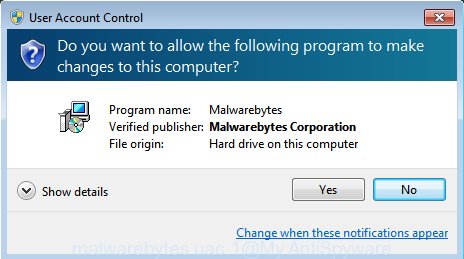
It will display the “Setup wizard” that will assist you install MalwareBytes on the system. Follow the prompts and don’t make any changes to default settings.

Once setup is finished successfully, click Finish button. Then MalwareBytes will automatically launch and you can see its main window as on the image below.
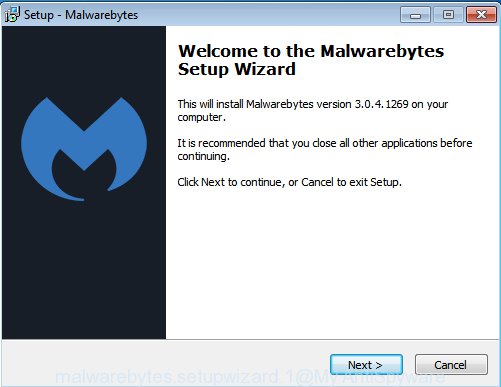
Next, click the “Scan Now” button to perform a system scan with this utility for the BrowserSafeguard that redirects your browser to intrusive ad sites. This task may take some time, so please be patient. During the scan MalwareBytes Anti Malware will find threats present on your machine.
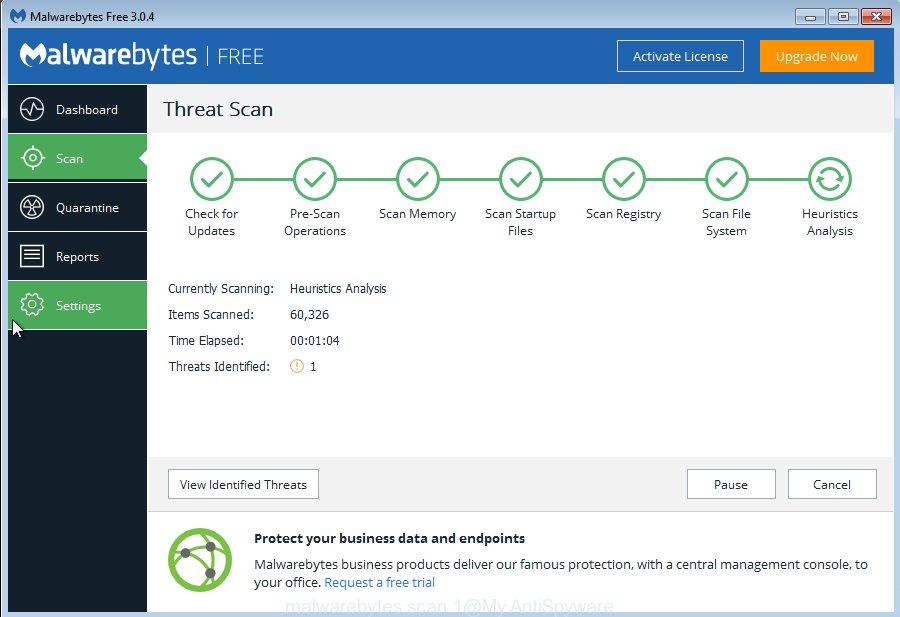
After finished, you will be opened the list of all detected items on your PC system. Review the scan results and then press “Quarantine Selected” button.
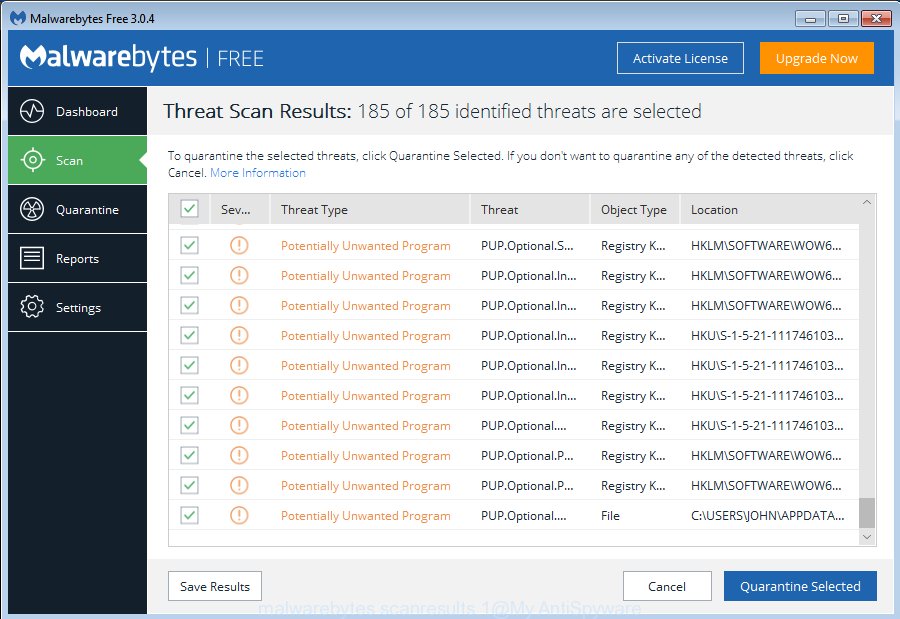
The MalwareBytes Anti Malware (MBAM) will remove BrowserSafeguard adware which designed to redirect your browser to various ad pages. After the clean up is done, you can be prompted to restart your personal computer. We recommend you look at the following video, which completely explains the procedure of using the MalwareBytes Anti-Malware (MBAM) to delete browser hijackers, adware and other malicious software.
Use AdwCleaner to delete BrowserSafeguard adware
The AdwCleaner utility is free and easy to use. It may check and get rid of malware, potentially unwanted software and ad-supported software in FF, Internet Explorer, Google Chrome and Edge web-browsers and thereby delete all undesired BrowserSafeguard pop-up ads. AdwCleaner is powerful enough to find and remove harmful registry entries and files that are hidden on the PC system.
Download AdwCleaner on your Microsoft Windows Desktop by clicking on the following link.
225535 downloads
Version: 8.4.1
Author: Xplode, MalwareBytes
Category: Security tools
Update: October 5, 2024
When downloading is finished, open the file location. You will see an icon like below.
![]()
Double click the AdwCleaner desktop icon. After the utility is opened, you will see a screen as shown in the figure below.
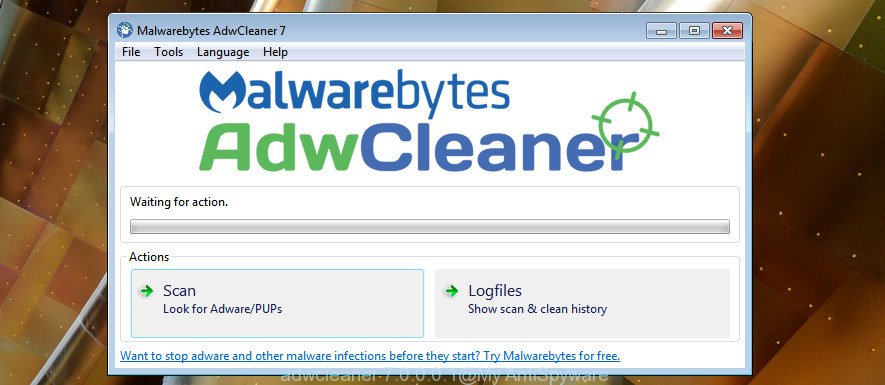
Further, click “Scan” button to start scanning your PC system for the BrowserSafeguard ad supported software that created to redirect your web browser to various ad web pages. This task can take some time, so please be patient. When AdwCleaner completes the scan, AdwCleaner will open a scan report as shown in the figure below.
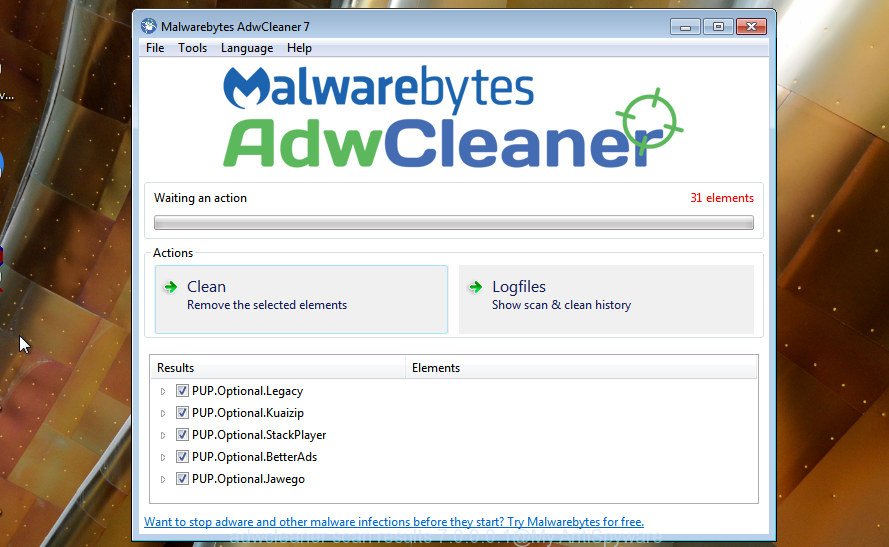
All found items will be marked. You can remove them all by simply press “Clean” button. It will show a dialog box as shown in the following example.

You need to click “OK”. When finished, the AdwCleaner may ask you to reboot your computer. When your system is started, you will see an AdwCleaner log.
These steps are shown in detail in the following video guide.
Stop unwanted pop-up ads and other intrusive web-pages
Use adblocker program such as AdGuard in order to block ads, malvertisements, pop-ups and online trackers, avoid having to install malicious and adware browser plug-ins and add-ons which affect your machine performance and impact your PC system security. Surf the Internet anonymously and stay safe online!
Download AdGuard on your personal computer from the following link.
26839 downloads
Version: 6.4
Author: © Adguard
Category: Security tools
Update: November 15, 2018
After the download is done, double-click the downloaded file to start it. The “Setup Wizard” window will show up on the computer screen as displayed on the image below.

Follow the prompts. AdGuard will then be installed and an icon will be placed on your desktop. A window will show up asking you to confirm that you want to see a quick guide as shown on the image below.

Press “Skip” button to close the window and use the default settings, or click “Get Started” to see an quick guidance which will assist you get to know AdGuard better.
Each time, when you run your PC system, AdGuard will launch automatically and stop ads, as well as other harmful or misleading web-pages. For an overview of all the features of the program, or to change its settings you can simply double-click on the AdGuard icon, that can be found on your desktop.
Where the BrowserSafeguard adware comes from
These days certain freeware makers bundle bundled software which could be PUPs like this adware, with a view to making some money. These are not freeware as install an unwanted applications on to your Microsoft Windows computer. So whenever you install a new free application that downloaded from the Internet, be very careful during setup. Carefully read the EULA (a text with I ACCEPT/I DECLINE button), choose custom or manual installation type, disable all optional software.
To sum up
Now your machine should be free of the BrowserSafeguard that causes multiple annoying advertisements and pop ups. Remove AdwCleaner. We suggest that you keep AdGuard (to help you block unwanted ads and intrusive harmful pages) and Zemana AntiMalware (to periodically scan your PC for new ‘ad supported’ softwares and other malicious software). Probably you are running an older version of Java or Adobe Flash Player. This can be a security risk, so download and install the latest version right now.
If you are still having problems while trying to remove BrowserSafeguard ‘ad supported’ software from the Edge, Internet Explorer, Google Chrome and Firefox, then ask for help in our Spyware/Malware removal forum.




















